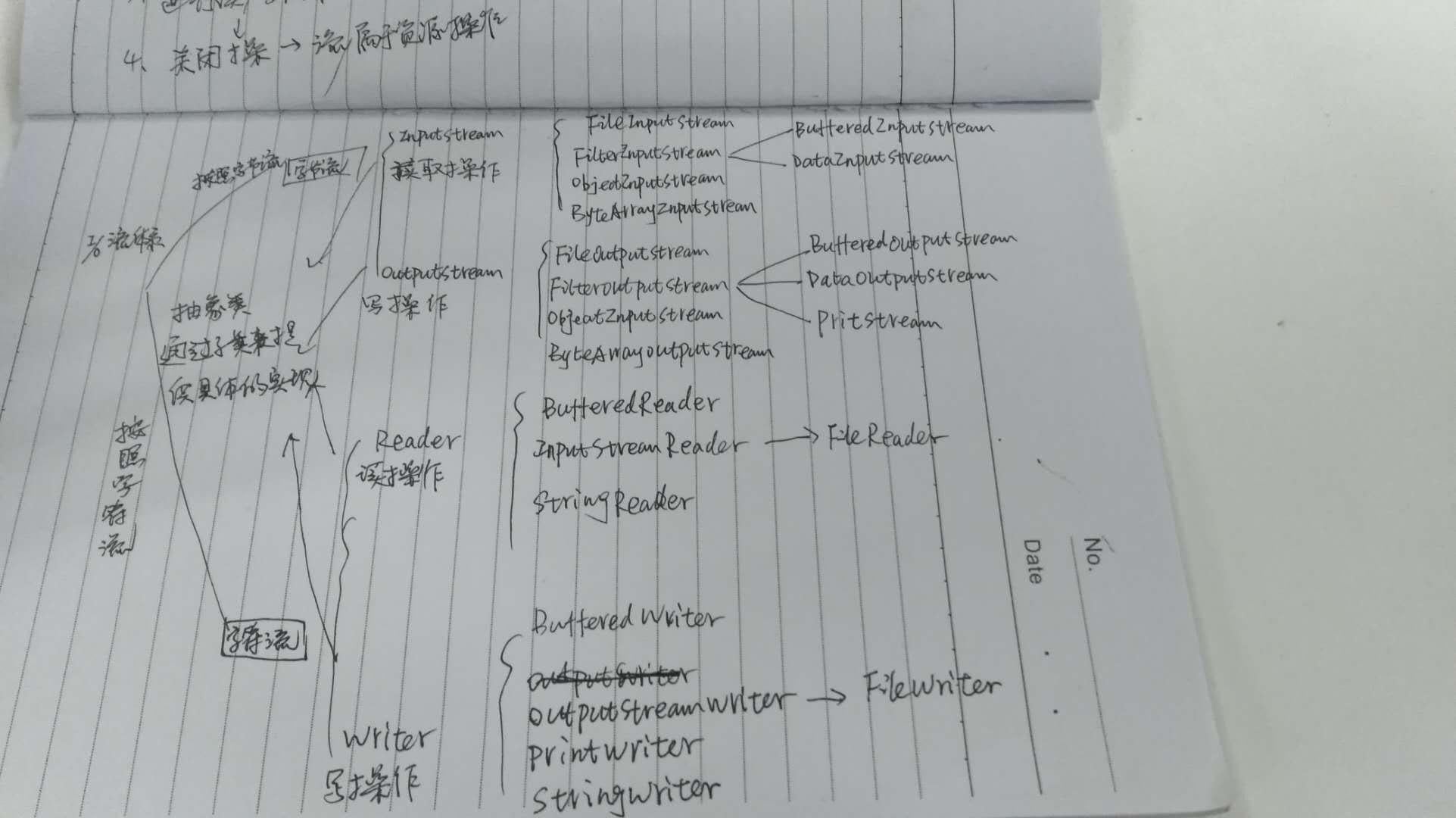java基础之-I/O流和File类解析
在日常的java开发中少不了文件的读取和 写入,这就涉及到文件的I/O操作,今天就来总结下文件的IO操作,顺便文件的IO操作也需要File了的帮助,所以一起总结了。
以下图片为我根据其他博客所总结的内容进行了相应的总结和IO流的类结构图,类结构图中还少了几个类
简单描述下:
IO分为字节和字符流2中方式,字节流以byte为单位,字符流以字符为单位,1个字节8byte 0·255,字节流的抽象类为inputstream和outputstream,他们无法实例化,所以需要
其子类来实现。字符流通常按2个字节来表示则为16byte,字符流的抽象类为reader和writer。
字符流通常是需要将文件读取到内存才能进行操作的,而字节流则是直接操作文件的。


还是通过具体的例子来说明吧。
@Test
public void testFileReader() throws IOException {
File file = new File("D:/train/train.txt");
FileInputStream fs = new FileInputStream(file);
InputStreamReader reader = new InputStreamReader(fs,"utf8");
BufferedReader bufferedReader = new BufferedReader(reader);
System.out.println(bufferedReader.readLine());
// 关闭文件流
bufferedReader.flush(); bufferedReader.close();
reader.close();
fs.close();
} @Test
public void testFileOut() throws IOException {
File file = new File("D:/train/train.txt");
FileOutputStream out = new FileOutputStream(file);
String str = "hello world";
out.write(str.getBytes("utf8"));
out.close();
}
上面的代码包含了文件的读取和文件的写入,包含字符集设置,读取操作其实可以包含了IO中绝大多数的操作了。需要注意的是不管是字节流,还是字符流他们的read()方法返回的结果都是int类型,需要将其转换成char类型。具体的源码可以根据类的结构树去查看。
一上为简单总结了IO流,下面是File类的总结:



File -> FileSystem -> WinNTFileSystem
操作文件其实通过操作系统的文件功能来实现的,不同的系统如windows和UNIX其实是不同的,新建的File通过getFileSystem()方法获取系统操作文件的权限,每个新建的文件都包含2个重要参数path和prefixLength
/**
* This abstract pathname's normalized pathname string. A normalized
* pathname string uses the default name-separator character and does not
* contain any duplicate or redundant separators.
* 这个抽象路径的正常路径名称,"d:/program file/train"这种格式
* @serial
*/
private final String path; /**
* The length of this abstract pathname's prefix, or zero if it has no
* prefix. 抽象路径的前缀长度,不存在则为0
*/
private final transient int prefixLength;
文件系统的操作其实很多都是通过这个前缀来创建文件的。
通过看源码可以发现,File类其实有点像接口,而WinNTFileSystem类则像实现接口。
看下File的构造函数,其中通过uri的构造函数没有贴出,有需要可以自己去查阅
/**
* Creates a new <code>File</code> instance by converting the given
* pathname string into an abstract pathname. If the given string is
* the empty string, then the result is the empty abstract pathname.
*
* @param pathname A pathname string
* @throws NullPointerException
* If the <code>pathname</code> argument is <code>null</code> 最通用给构造函数,通过文件路径来创建文件
*/
public File(String pathname) {
if (pathname == null) {
throw new NullPointerException();
}
this.path = fs.normalize(pathname);
this.prefixLength = fs.prefixLength(this.path);
} /**
* Creates a new <code>File</code> instance from a parent pathname string
* and a child pathname string.
*
* <p> If <code>parent</code> is <code>null</code> then the new
* <code>File</code> instance is created as if by invoking the
* single-argument <code>File</code> constructor on the given
* <code>child</code> pathname string.
*
* <p> Otherwise the <code>parent</code> pathname string is taken to denote
* a directory, and the <code>child</code> pathname string is taken to
* denote either a directory or a file. If the <code>child</code> pathname
* string is absolute then it is converted into a relative pathname in a
* system-dependent way. If <code>parent</code> is the empty string then
* the new <code>File</code> instance is created by converting
* <code>child</code> into an abstract pathname and resolving the result
* against a system-dependent default directory. Otherwise each pathname
* string is converted into an abstract pathname and the child abstract
* pathname is resolved against the parent.
* 通过父路径和子路径来创建文件
* @param parent The parent pathname string
* @param child The child pathname string
* @throws NullPointerException
* If <code>child</code> is <code>null</code>
*/
public File(String parent, String child) {
if (child == null) {
throw new NullPointerException();
}
if (parent != null) {
if (parent.equals("")) {
this.path = fs.resolve(fs.getDefaultParent(), -->"/"
fs.normalize(child));
} else {
this.path = fs.resolve(fs.normalize(parent),
fs.normalize(child));
}
} else {
this.path = fs.normalize(child);
}
this.prefixLength = fs.prefixLength(this.path);
} /** 通过父文件和子路径来创建文件
* Creates a new <code>File</code> instance from a parent abstract
* pathname and a child pathname string.
*
* <p> If <code>parent</code> is <code>null</code> then the new
* <code>File</code> instance is created as if by invoking the
* single-argument <code>File</code> constructor on the given
* <code>child</code> pathname string.
*
* <p> Otherwise the <code>parent</code> abstract pathname is taken to
* denote a directory, and the <code>child</code> pathname string is taken
* to denote either a directory or a file. If the <code>child</code>
* pathname string is absolute then it is converted into a relative
* pathname in a system-dependent way. If <code>parent</code> is the empty
* abstract pathname then the new <code>File</code> instance is created by
* converting <code>child</code> into an abstract pathname and resolving
* the result against a system-dependent default directory. Otherwise each
* pathname string is converted into an abstract pathname and the child
* abstract pathname is resolved against the parent.
*
* @param parent The parent abstract pathname
* @param child The child pathname string
* @throws NullPointerException
* If <code>child</code> is <code>null</code>
*/
public File(File parent, String child) {
if (child == null) {
throw new NullPointerException();
}
if (parent != null) {
if (parent.path.equals("")) {
this.path = fs.resolve(fs.getDefaultParent(),
fs.normalize(child));
} else {
this.path = fs.resolve(parent.path, --> 将父文件转换成路径,然后和子路径拼接
fs.normalize(child));
}
} else {
this.path = fs.normalize(child);
}
this.prefixLength = fs.prefixLength(this.path);
}
其他的一些方法如创建新文件,creatNewFile(),创建文件夹mkdir(),mkdirs()等方法,相信看下源码就能很清楚了。
java基础之-I/O流和File类解析的更多相关文章
- java基础9(IO流)-File类
File类 File:文件和目录路径名的抽象表示形式.即java中把文件或者目录都封装成File对象 代码练习1 import java.io.File; public class FileDemo1 ...
- 【Java基础】【19异常&IO(File类)】
19.01_异常(异常的概述和分类) A:异常的概述 异常就是Java程序在运行过程中出现的错误. B:异常的分类 通过API查看Throwable Error 服务器宕机,数据库崩溃等 Except ...
- IO流,File类的测试........课堂加总结
package liu0926; import java.io.File; import java.io.IOException; public class Text01 { public stati ...
- Java基础系列2:深入理解String类
Java基础系列2:深入理解String类 String是Java中最为常用的数据类型之一,也是面试中比较常被问到的基础知识点,本篇就聊聊Java中的String.主要包括如下的五个内容: Strin ...
- java基础——IO流之File类
1.File类的构造方法: File(String pathName):通过一个指定的字符串类型路径来创建一个文件对象 File (String parent,String child):通过指定 ...
- Java基础系列8——IO流超详细总结
该系列博文会告诉你如何从入门到进阶,一步步地学习Java基础知识,并上手进行实战,接着了解每个Java知识点背后的实现原理,更完整地了解整个Java技术体系,形成自己的知识框架. 在初学Java时,I ...
- Java基础之详谈IO流
Java基础知识.IO流详细讲解.你所要的IO这里都有
- Java笔记(二十七)……IO流中 File文件对象与Properties类
File类 用来将文件或目录封装成对象 方便对文件或目录信息进行处理 File对象可以作为参数传递给流进行操作 File类常用方法 创建 booleancreateNewFile():创建新文件,如果 ...
- -1-4 java io java流 常用流 分类 File类 文件 字节流 字符流 缓冲流 内存操作流 合并序列流
File类 •文件和目录路径名的抽象表示形式 构造方法 •public File(String pathname) •public File(String parent,Stringchild) ...
随机推荐
- 关于IT公司技术委员会职责
技术委员会的核心职责 组织人才相关 • 制定职级标准 - 能力框架:知识,技能,通用素质 - 职级标准:T2T3T4-P7P8P9- • 职级评审,对齐标准 • 高端招聘,对齐标准 • 校园招聘,对齐 ...
- sqlserver2012 在视图中建索引
第一种 如果已经有视图但是要加索引只需要执行 以下SQL就好(前提是此视图必须 绑定到架构) CREATE UNIQUE CLUSTERED INDEX in ...
- 使用exceljs时报错:no such file or directory
最近使用exceljs生成excel并保存时,总是失败 await workbook.xlsx.writeFile(tep) .then(function () { context.result = ...
- 12.22 大湾区.NET Meet 大会
今年的 Connect(); 主题更加聚焦开发者工具生产力.开源,以及无服务器(Serverless)云服务. Visual Studio 2019 AI 智能加持的 IntelliCode.实时代码 ...
- Java面试题:Java中怎么样实现多线程
方法一:继承 Thread 类,覆盖方法 run(),我们在创建的 Thread 类的子类中重写 run() ,加入线程所要执行的代码即可. 下面是一个例子: public class MyThrea ...
- C语言字符/字符串相关函数收藏
字符串的声明与使用 定义一个可变的字符串: char ch[]={"123456abc"}; char ch2[5]={"123456789"}; //会出现警 ...
- cassandra 堆外内存管理
为什么需要堆外内存呢 单有一些大内存对象的时候,JVM进行垃圾回收时需要收集所有的这些对象的内存也.增加了GC压力.因此需要使用堆外内存. java 分配堆外内存 org.apache.cassand ...
- javaScript设计模式之面向对象编程(object-oriented programming,OOP)(一)
面试的时候,总会被问到,你对javascript面向对象的理解? 面向对象编程(object-oriented programming,OOP)是一种程序设计范型.它讲对象作为程序的设计基本单元,讲程 ...
- 《HelloGitHub》第 30 期
公告 截止到第 30 期,贡献者 终于到达 3 位数-- 100 位.谢谢各位的支持和贡献,想要加入的小伙伴,快来推荐项目吧! <HelloGitHub>第 30 期 兴趣是最好的老师,H ...
- 学习ASP.NET Core Razor 编程系列十一——把新字段更新到数据库
学习ASP.NET Core Razor 编程系列目录 学习ASP.NET Core Razor 编程系列一 学习ASP.NET Core Razor 编程系列二——添加一个实体 学习ASP.NET ...
